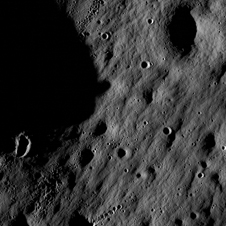Graduate Student Spotlight: Charting the Moon’s history with lunar craters
 Marley Chertok
Marley ChertokThe story below was written by Nina Shuping for the Hawai‘i Institute of Geophysics and Planetology.
For those wondering what lunar soil smells like, Marley Chertok, a graduate student working in the Hawai‘i Institute of Geophysics and Planetology (HIGP), will tell you that it smells like smoked meat in an old basement. Being able to be independent and focus on topics of interest to her while being homeschooled set Marley up for success in college studying geology. During her time in college at Temple University, she studied hydrology and worked for the The Academy of Natural Sciences in Philadelphia doing water quality research, furthering her laboratory expertise. However, Marley describes the field camp she did mapping geologic units in Wyoming and South Dakota as the most impactful towards her passion for field work.
“That experience contributed deeply to the geologist I am today,” she stated.
When she was nominated for an internship with the U.S. Geological Survey (USGS), she had the opportunity to work on the identification of spectral properties of cyanobacteria in order to better predict harmful algal blooms. This first exposure and work with spectroscopy, which is the study of how different objects absorb and radiate light in the electromagnetic spectrum, opened the door to other interesting applications of the science for Marley.
Transitioning into a more spectroscopy role, Marley was part of a team observing land use changes, and environmental impacts of refugee settlements in Zambia. In this study the research team was comparing the land use change of two different settlements, one in a tropical climate and another in a dry climate. The science team determined how protracted refugee settlements affect the environment and made recommendations for how emergency settlements can be better planned with both environmental and human needs in mind.
Shifting focus to space science
With more experience in remote sensing tools she got involved with the Astrogeology Science Center at USGS, where she worked studying the regolith on the Moon. Marley is currently pursuing a doctoral degree in Earth and Planetary Science at the University of Hawaiʻi at Mānoa. Immersed in research at HIGP with professor Paul Lucey, Marley recently defended her thesis focused on studying impact craters on the Moon.
“I started studying impact craters [and] I felt like I really understood it,” said Marley. “It is a fun challenge and I love being able to contribute little pieces [of knowledge] of solar system processes. It feels empowering and helps build confidence, and I hope to apply this information to other planetary bodies as well.”
Marley has been assessing impact craters to probe the subsurface of the Moon to better understand what the Moon was once like. Impact craters are a common tool used by planetary scientists to help date different areas of a terrestrial planet’s surface. As a general trend, older surfaces will have more craters. This is because more time will have elapsed and there will have been a longer period for craters to impact that area. Additionally, our solar system was once more chaotic than it is now and surfaces that were exposed during that time will have more craters.

While new evidence shows that the Moon might still be geologically active, we know that it was previously far more active because we are able to see the remnants of extensive lava flows that have covered old cratered surfaces. These are the large dark patches you can see when looking at the Moon and are called lunar maria. The light areas of the Moon are the heavily cratered areas called the highlands. Marley’s research lies in understanding the nuances of the Moon’s surface and challenging the idea that lava flows on the Moon are homogeneous. The Moon’s lava flows may be more diverse than we expected.
In Marley’s work, she is comparing craters in the highlands to craters in the mare using ejecta blankets and crater depth to understand the Moon’s regolith, the top layer of unconsolidated material above the bedrock. When an impactor hits the lunar surface it excavates the regolith and throws rocks into the air, which land on the surrounding surface, this is called the ejecta blanket. More rocks strewn about around the crater is an indicator of a thin regolith.
Exploring solar system processes
Marley hopes that her work will take her “figuratively to the Moon and beyond. I hope that by understanding the Moon we can better understand the planetary processes of other bodies. We can use craters to shed light on the subsurface of planets.” She is also excited by how this kind of work changes when dealing with icy bodies. “Impact craters on ice will behave differently than rocky surfaces due to their composition and relative strength.”
Knowing that many terrestrial planets have icy surfaces, the future work in this area is vast. This is one of the things that she really enjoys about being part of HIGP, there are opportunities to “dabble in different areas of work.” On ‘dabbling,’ Marley sees this as a key to success, “I want to dabble in everything and have dabbled in a lot of things,” and suggests to other students that “It is good to try different fields, [at UH] it is not hard to get involved […] you have to practice pursuing things and be eager and interested. I tried a bunch of things and I am glad I did!”




